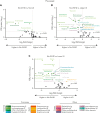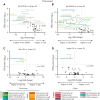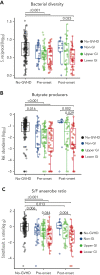Preservation of the fecal microbiome is associated with reduced severity of graft-versus-host disease
- PMID: 35969834
- PMCID: PMC9837450
- DOI: 10.1182/blood.2021015352
Preservation of the fecal microbiome is associated with reduced severity of graft-versus-host disease
Erratum in
-
Burgos da Silva M, Ponce DM, Dai A, et al. Preservation of the fecal microbiome is associated with reduced severity of graft-versus-host disease. Blood. 2022;140(22):2385-2397.Blood. 2023 Mar 9;141(10):1234. doi: 10.1182/blood.2023019750. Blood. 2023. PMID: 36893004 Free PMC article. No abstract available.
Abstract
Following allogeneic hematopoietic cell transplantation (allo-HCT), the gastrointestinal (GI) tract is frequently affected by acute graft-versus-host disease (aGVHD), the pathophysiology of which is associated with a dysbiotic microbiome. Since microbial composition varies along the length of the GI tract, the authors hypothesized that microbiome features correlate with the pattern of organ involvement after allo-HCT. We evaluated 266 allo-HCT recipients from whom 1303 stool samples were profiled by 16S ribosomal gene sequencing. Patients were classified according to which organs were affected by aGVHD. In the 20 days prior to disease onset, GVHD patients had lower abundances of members of the class Clostridia, lower counts of butyrate producers, and lower ratios of strict-to-facultative (S/F) anaerobic bacteria compared with allograft recipients who were free of GVHD. GI GVHD patients showed significant reduction in microbial diversity preonset. Patients with lower GI aGVHD had lower S/F anaerobe ratios compared with those with isolated upper GI aGVHD. In the 20 days after disease onset, dysbiosis was observed only in GVHD patients with GI involvement, particularly those with lower-tract disease. Importantly, Clostridial and butyrate-producer abundance as well as S/F anaerobe ratio were predictors of longer overall survival; higher abundance of butyrate producers and higher S/F anaerobe ratio were associated with decreased risk of GVHD-related death. These findings suggest that the intestinal microbiome can serve as a biomarker for outcomes of allo-HCT patients with GVHD.
© 2022 by The American Society of Hematology.
Conflict of interest statement
Conflict-of-interest disclosure: D.M.P. has served as advisory board member for Evive Biotechnology (Shanghai) Ltd (formerly Generon [Shanghai] Corporation Ltd); has consulted, received honorarium from, or particpated in advisory boards for Kadmon Corporation/Sanofi, CareDx, Ceramedix, and Incyte; has received research support from Incyte. A.L.C.G. reports equity, salary and is employed by Xbiome Co. R.S. received consultancy fees from Medexus and MyBiotics. M.-A.P. reports honoraria from Adicet, Allovir, Caribou Biosciences, Celgene, Bristol-Myers Squibb, Equilium, Exevir, Incyte, Karyopharm, Kite/Gilead, Merck, Miltenyi Biotec, MorphoSys, Nektar Therapeutics, Novartis, Omeros, OrcaBio, Syncopation, VectivBio AG, and Vor Biopharma. He serves on DSMBs for Cidara Therapeutics, Medigene, and Sellas Life Sciences, and the scientific advisory board of NexImmune. He has ownership interests in NexImmune and Omeros. He has received institutional research support for clinical trials from Incyte, Kite/Gilead, Miltenyi Biotec, Nektar Therapeutics, and Novartis. J.U.P. reports research funding, intellectual property fees, and travel reimbursement from Seres Therapeutics and consulting fees from DaVolterra, CSL Behring, and MaaT Pharma. He serves on an advisory board of and holds equity in Postbiotics Plus Research. He has filed intellectual property applications related to the microbiome (reference numbers 62/843,849, 62/977,908, and 15/756,845). M.R.M.v.d.B. has received research support and stock options from Seres Therapeutics and stock options from Notch Therapeutics and Pluto Therapeutics; he has received royalties from Wolters Kluwer; has consulted, received honorarium from or participated in advisory boards for Seres Therapeutics, Vor Biopharma, Rheos Medicines, Frazier Healthcare Partners, Nektar Therapeutics, Notch Therapeutics, Ceramedix, Lygenesis, Pluto Therapeutics, GlaxoSmithKline, Da Volterra, Thymofox, Garuda, Novartis (Spouse), Synthekine (Spouse), Beigene (Spouse), Kite (Spouse); he has IP Licensing with Seres Therapeutics and Juno Therapeutics; and holds a fiduciary role on the Foundation Board of DKMS (a nonprofit organization). Memorial Sloan Kettering Cancer Center (MSK) has financial interests relative to Seres Therapeutics. The remaining authors declare no competing financial interests.
Figures







Comment in
-
GVHD prediction based on the microbiome.Blood. 2022 Dec 1;140(22):2313-2314. doi: 10.1182/blood.2022017462. Blood. 2022. PMID: 36454594 No abstract available.
Similar articles
-
Microbiome: An Emerging New Frontier in Graft-Versus-Host Disease.Dig Dis Sci. 2019 Mar;64(3):669-677. doi: 10.1007/s10620-018-5369-9. Epub 2018 Dec 7. Dig Dis Sci. 2019. PMID: 30523482 Review.
-
Dental Biofilm Microbiota Dysbiosis Is Associated With the Risk of Acute Graft-Versus-Host Disease After Allogeneic Hematopoietic Stem Cell Transplantation.Front Immunol. 2021 Jun 18;12:692225. doi: 10.3389/fimmu.2021.692225. eCollection 2021. Front Immunol. 2021. PMID: 34220852 Free PMC article.
-
Alteration of Gut Microbiota Composition and Diversity in Acute and/or Chronic Graft-versus-Host Disease Following Hematopoietic Stem Cell Transplantation: A Prospective Cohort Study.Int J Mol Sci. 2024 May 26;25(11):5789. doi: 10.3390/ijms25115789. Int J Mol Sci. 2024. PMID: 38891979 Free PMC article.
-
The impact of intestinal microbiota in antithymocyte globulin-based myeloablative allogeneic hematopoietic cell transplantation.Cancer. 2022 Apr 1;128(7):1402-1410. doi: 10.1002/cncr.34091. Epub 2022 Jan 25. Cancer. 2022. PMID: 35077579
-
The role of fecal microbiota transplantation in the treatment of acute graft-versus-host disease.J Cancer Res Ther. 2024 Dec 1;20(7):1964-1973. doi: 10.4103/jcrt.jcrt_33_24. Epub 2025 Jan 10. J Cancer Res Ther. 2024. PMID: 39792405 Review.
Cited by
-
Pulmonary microbiome and transcriptome signatures reveal distinct pathobiologic states associated with mortality in two cohorts of pediatric stem cell transplant patients.medRxiv [Preprint]. 2023 Nov 29:2023.11.29.23299130. doi: 10.1101/2023.11.29.23299130. medRxiv. 2023. PMID: 38077035 Free PMC article. Preprint.
-
The delicate balance of graft versus leukemia and graft versus host disease after allogeneic hematopoietic stem cell transplantation.Expert Rev Hematol. 2023 Jul-Dec;16(12):943-962. doi: 10.1080/17474086.2023.2273847. Epub 2023 Dec 18. Expert Rev Hematol. 2023. PMID: 37906445 Free PMC article. Review.
-
Gut microbiota diversity before allogeneic hematopoietic stem cell transplantation as a predictor of mortality in children.Blood. 2023 Oct 19;142(16):1387-1398. doi: 10.1182/blood.2023020026. Blood. 2023. PMID: 37856089 Free PMC article.
-
Role of the microbiota in response to and recovery from cancer therapy.Nat Rev Immunol. 2024 May;24(5):308-325. doi: 10.1038/s41577-023-00951-0. Epub 2023 Nov 6. Nat Rev Immunol. 2024. PMID: 37932511 Review.
-
Operationalizing Team Science at the Academic Cancer Center Network to Unveil the Structure and Function of the Gut Microbiome.J Clin Med. 2025 Mar 17;14(6):2040. doi: 10.3390/jcm14062040. J Clin Med. 2025. PMID: 40142848 Free PMC article. Review.
References
-
- Hill GR, Ferrara JL. The primacy of the gastrointestinal tract as a target organ of acute graft-versus-host disease: rationale for the use of cytokine shields in allogeneic bone marrow transplantation. Blood. 2000;95(9):2754–2759. - PubMed
Publication types
MeSH terms
Substances
Grants and funding
LinkOut - more resources
Full Text Sources
Miscellaneous

